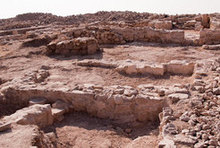8 Sep 2010, Silver Spring, Maryland, United States…Mark A. Kellner, Adventist Review/ Taylor Luck, The Jordan Times
Confirming a modern-day view of Bible history, a Seventh-day Adventist archaeologist and historian has unearthed pivotal ruins and artifacts from the 3,000-year-old Iron Age at a temple site in Ataruz, Jordan.
“[This is] the largest and best-preserved temple from the biblical period. It will shed important light on the cultic, or religious, life of that period,” said Dr. Chang Ho Ji, chairman and professor in the Counseling and School Psychology department and a collaborating faculty in the History department of La Sierra University, a Seventh-day Adventist school in Riverside, California.
Jordanian officials announced the discovery at a news conference in Amman on September 1.
“This is an extremely important find and one that has relationships to biblical history; it is very exciting,” said Dr. Lawrence Geraty, president emeritus of the school and an archaeology professor there, in an e-mail to Adventist Review. Geraty pioneered the cooperation among several Adventist institutions, including Atlantic Union College, Canadian Union College, Andrews University, and La Sierra, and the Hashemite Kingdom of Jordan, starting in 1984 with a dig at Tall al-‘Umayri.
Jordanian Department of Antiquities (DoA) Director General Ziad Saad announced the recent discovery as the largest early Iron Age II temple in the region, dating back to between 1000 and 800 BC.
The multi-chambered temple, which includes a 20-by-20-meter courtyard, yielded over 300 cultic artifacts, leading experts to believe it was once a political and religious base for either the Moabite or the northern Israelite kingdom.
Vessels, jars and statues of deities were among recent temple-related discoveries at Khirbet Ataruz, near Dhiban, approximately 30 miles south of Amman, located on the western slope of Jabal Bani Hamida. The actual site is just off the road leading to the site of King Herod the Great’s winter palace, Dr. Ji said.
According to media reports, the items, many of which were unearthed last month, give experts a more complete view of the Iron Age civilization and Jordan’s heritage.
More than 1,000 years before the Nabataeans built an empire of trade through the rose-red, rock-hewn city of Petra, the Moabites, Ammonites and Edomites dominated the region in what is seen as a time of science, expansion and culture, the Jordan Times indicated in a news report.
“This is a very important period of Jordan’s history. The Iron Age was a period of great historical and political importance and strong kingdoms that saw many technological advancements,” Saad said.
Ataruz is mentioned both in the Bible and the Mesha Stele as “Ataroth,” but the true meaning of the name “has yet to be uncovered,” Saad told The Jordan Times.
Although historical documents frequently refer to the Iron Age kingdoms east of the River Jordan, Saad pointed out that the Khirbet Ataruz findings mark the first time experts have archaeological evidence to back up theories of the civilization’s scientific, cultural and economic sophistication.
The bulk of the historic findings were uncovered in August by a La Sierra University team that has been excavating Khirbet Ataruz since 2000 with support from Versacare, Inc., a charity in Riverside.
Among the findings are a statue of a bull-faced god and nearly 300 vessels, lamps and altars for religious rituals. In antiquity, the bull was often tied to the principal deities of the region, including El, Hadad and Baal.
The quality, diversity and condition of the pieces, made from clay, stone, basalt and bronze, show an advanced technology and a thriving economy on the east bank of the River Jordan more than three millennia ago.
Despite being in good condition, most of the Ataruz pieces were broken, indicating that the temple in central Jordan met a violent end, Saad said.
Much of what is known of the Ataruz temple has been learned from King Mesha, immortalized in a basalt tablet listing his victories and accomplishments. Known as the Mesha Stele, the tablet was discovered near Dhiban and is now on display in the Louvre in Paris.
The Moabites — whom the Bible says are descended from Moab, a grandson of Lot and a nephew of Abraham — are believed to have been Canaanite tribes that settled in the land between the River Jordan and the Eastern Desert near what is now Dhiban in the 14th century BC. Their reign came to an end with the Persian invasion around the 7th century BC.
According to Saad, experts will now work to catalogue, test and research the Ataruz artifacts in order to get a full picture of the Iron Age kingdoms that once ruled Jordan.
–portions of this report are reprinted, with the author’s permission, from a news article in the September 2 issue of The Jordan Times.

